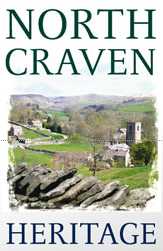| JOURNAL 2011 |
| North Craven Heritage Trust |
Three hardy souls braved the elements and set off up a very old walled lane beside Giggleswick Chapel on route to Close House. In the 15th century Close House was a double messuage, owned by an absentee landlord, George Clifford 3rd Earl of Cumberland. By 1604 the Earl was almost bankrupt and started to sell off his lands and property, both in Giggleswick and elsewhere. Wills and inventories had been studied to glean information about the various inhabitants of Close House, starting with Bernard Brown’s will of 1576 and finishing with William Procter’s will of 1840. William must have been a wealthy man for apart from leaving various properties and lands to his sons he declared that his son John was to pay £1200 plus interest to John’s children for their upkeep and education.
At Grain House, Field Gate and Rome, details were found relating to the provision made in wills for the maintenance of widows, mothers, sisters and daughters. Richard Carr in 1593 declares that his wife should look after his mother ‘so long as my mother and my wife can agree, when they cannot agree then the husbandry gear to be divided between them’!- pitchforks at dawn? Taxes due for the period 1800 were also looked at for Grain House, including £1.14s.0d. due for ten windows.
By now the sun had come out and we were rewarded with far-reaching views back towards Ingleborough. Ahead lay our final destination, the Coney Garths or rabbit warrens, north of Swainstead. These impressive remains are situated on marginal sloping ground, as was the norm, and provided meat and fur on a large scale. In the medieval period warrens were a status symbol and were proudly displayed in parks and beside great mansions. The warrens were in decline by the mid-Victorian period and the death knell came with myxomatosis in the 1950s.
